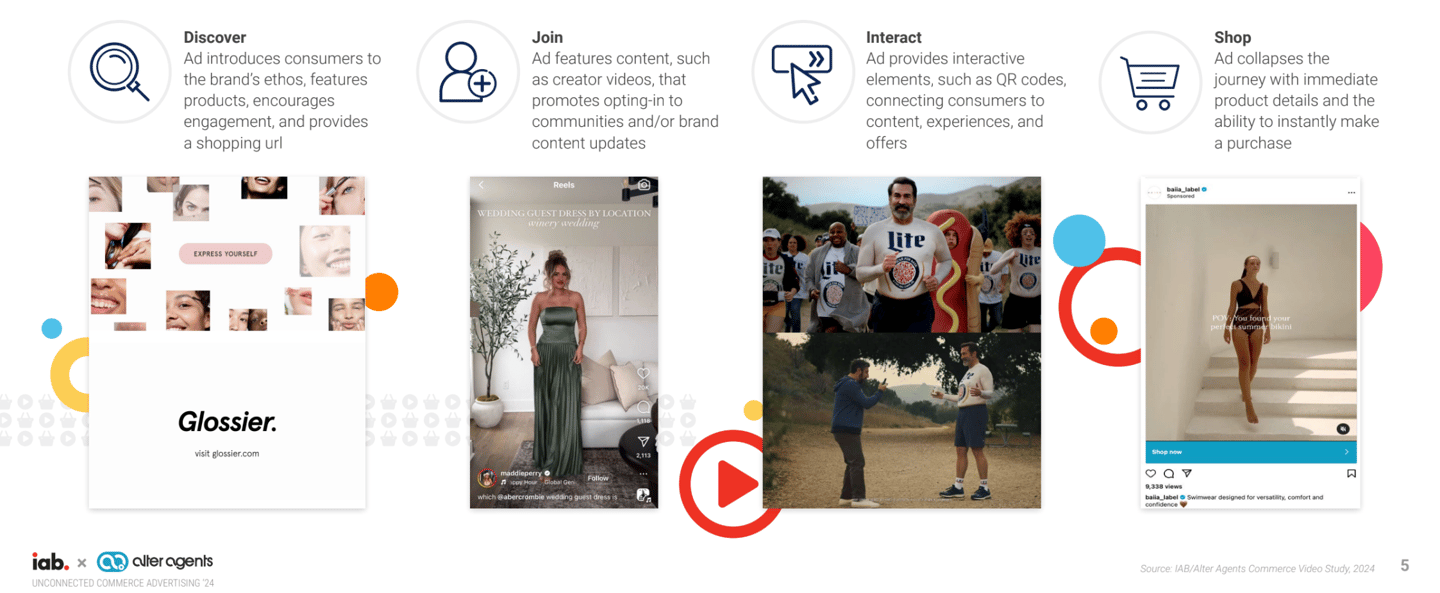Commerce Video Engagement is Soaring, But Advertisers Are Missing the Mark
In a new study, the Interactive Advertising Bureau (IAB) analyzes the rise of commerce video, which 70% of digital video advertisers are already leveraging and nearly all of them plan to spend more on it in the future.
The report, titled “Unconnected Commerce: the Disconnect between Brands and Consumers in Digital Video Shopping,” indicates the upward trajectory this ad format is on, while highlighting a gap in what consumers want and what advertisers are delivering. Consumers increasingly want a condensed purchasing funnel that blends product discovery and purchasing into one seamless experience.
“As the purchase journey collapses, digital video is no longer just an awareness and consideration tool, it is now a critical strategy in driving business outcomes like sales, store/site visits, leads, downloads, etc.,” David Cohen, CEO, IAB, said in a statement on the findings. “This report found that while brands are embracing commerce video, there is room to improve the experience based on consumer needs and preferences. Commerce video works — this study reveals how to unlock its full potential.”
Defining Commerce Video
With digital video — connected TV (CTV), social video and online video — dominating consumers' digital media consumption, brands are capitalizing on commerce video as a powerful way to engage with them at scale. The term “commerce video” is not part of consumers’ or advertisers’ vernacular, yet it is surging amongst both groups.
In fact, nearly all (95%) commerce video advertisers use these ads more often now than other media to drive purchases, according to the consumer and marketer study, conducted in partnership with research consultancy Alter Agents. Additionally, three-quarters of consumers feel that the ads are more relevant to their purchase process than other ad types, and that commerce video helps them make better purchasing decisions overall.
The study defines commerce video as “digital video ads designed to drive action, especially purchase.” These videos include a clear call-to-action that places the consumer into the “purchase journey” resulting in a lead or purchase (e.g., “sign up”, “learn more” and “shop now”).
“Nearly every advertiser we surveyed plans to increase their spend on commerce video in 2025, so it’s critical that we, as an industry, have a unified definition for what this medium does and how it should be used,” added Chris Bruderle, vice president, industry insights & content strategy, IAB. “While extremely effective, if used incorrectly, commerce media can be detrimental to brand loyalty and ultimately sales. Plainly said, commerce video is not a blunt instrument. There are nuances that brands need to take into consideration.”
The Commerce Video Gap Between Consumers and Advertisers
According to the study, advertisers are overconfident when it comes to deploying commerce video campaigns. Nearly all advertisers (96%) feel their messaging strategies are effective at driving purchases. However, 7-in-10 consumers report feeling annoyed or negative monthly or more often with commerce video ads, and one-third at least weekly. In fact, these poor experiences can lead to negative consumer reactions such as social media backlash, switching to competitors and unsubscribing from services.
Advertisers have an opportunity to better align on these strategies, including refining their messaging, campaign timing, delivery throughout the purchasing journey and more (see table below).
“While many marketers believe their commerce video ad strategies are effective, consumer sentiment would indicate that there is significant room for improvement. There is a delicate balance that advertisers must walk when it comes to campaign targeting, timing, and delivery to achieve optimal outcomes. If advertisers adjust their go-to-market approach as the study indicates, the future is bright for commerce video,” Cohen said.
Other Key Takeaways From the Report Include:
- At an average of 4 hours per day, half of consumers’ daily media diet is spent with digital video – up 30% over the last three years.
- 81% of consumers agree that commerce video ads are more helpful for making purchase decisions than other types of ads.
- Ad buyers’ investments in the channel (e.g., CTV, online video & social video) rose 15% in 2023 to $54 billion and are projected to grow 16% in 2024 to $63 billion – nearly 80% faster than total media overall.
- Consumers find commerce video more memorable, relevant, engaging and informative than other media types and feel that it provides a “brick-and-mortar” experience in the e-commerce era.
- Gen Z and Millennials are 58% more likely than older generations to recall these ads.
- Consumers find commerce video’s inclusion of clear product demonstrations, details, cost and promotional information most helpful when making purchase decisions.
- Ads that were more storytelling focused or unfocused in general were rated as less influential to making purchases.
- 63% of consumers, when annoyed by a commerce video ad, will take action to disparage a brand, sever their relationship with the brand and/or stop purchasing their products.
Methodology
IAB partnered with Alter Agents to conduct a comprehensive study of over 1,000 consumers and 300 marketers combining quantitative, qualitative and ethnographic research to generate these results.











